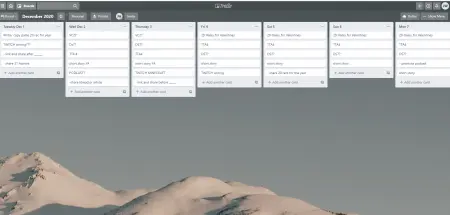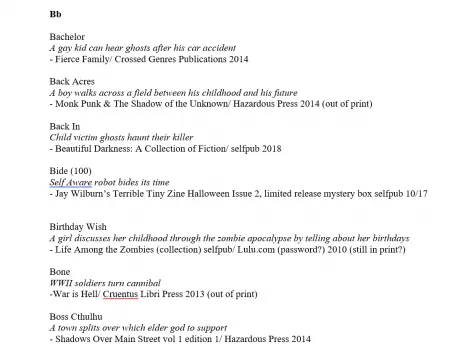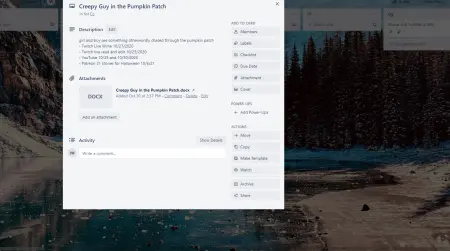Trello is an online organizational tool for individuals, teams, and businesses. There is a free version and then a paid version with lots of bells and whistles. The free version has everything I need for now. There are a number of tutorial videos you can find on YouTube about general features and applications for team projects in a corporate setting. I’m going to focus on how I use Trello for myself as an author.
Getting started is as easy as going to Trello.com and signing up. But how do you use it?
Don’t get overwhelmed by this overview. Just go with it and I’ll explain with specific examples as we go. The structure of Trello is broken down into boards, lists, and cards. Boards would be like pages on a website. On each board, you create lists side by side, horizontally across the board, as many as you need. On each list, you create cards that stack up vertically as far down as you need. On each card, you can add notes, attach files, and make comments. These can be seen by clicking on cards.
If it is a group project, every team member invited to the board can be assigned tasks on specific cards on the list. If you work for multiple companies or teams who are on Trello, you can access all the boards you are invited to from your own Trello account and see the tasks and projects you are assigned as you organize your work.
So, Trello is broken up into boards. If you click on a board, you’ll see your lists and the cards on those lists. If you click on a card, you’ll see any details, notes, or attachments included on that card.
Project Dark Insurgence
To make sense of this, let’s say you are a freelance writer for a media company and you work from home. You are never going into the physical office. The company’s Trello has its work broken into boards. There’s a board for feature films, a board for trainings, a board for the company’s podcast, a board for the website, a board for promotional videos, and a board called Project Dark Insurgence that you have no idea about, but it scares you a little when you are alone with your thoughts. You are only contracted for writing scripts for promotional videos, so that’s the only board you’re invited to.
On the promotional video board, each video project is a separate list. On each project list are cards for content, script, shooting, editing, uploading, and sharing. The cards have deadlines and other details. Two project managers discuss the content on a card. You are tagged on that. You are also tagged on the script writing. They may have you email the script, attach it to card when complete, or both. As projects are completed, the cards and lists may be archived to get them out of the way.
Later, they expand your contract to include blog posts, so you are invited to the website board, too. Blogs may be a list with each card on the list being a new post they need. The lists may be divided by the pages on the site, and content you need to write is on cards on several different lists, but you’re tagged on the ones related to you. The company may use color coding, too.
One day, one of the department heads from the Project Dark Insurgence board tags you in a conversation on the Eastern European Investments list saying, “This might make a good blog post.” Now you must decide, do you simply write the blog post, or do you warn a washed-up-alcoholic-former-FBI-agent-with-a-photographic-memory-and-poor-people-skills and his upbeat female sidekick what Project Dark Insurgence is planning?
That’s Trello!
Here are some ways I use it for my personal organization as an author:
-Daily Planning Calendar
I do not use Trello exactly as it is designed to be used.
I’m a full-time author. No one tracks my organizational system except me. For years, I have written a Post-It note for every day. On that Post-It, I list off all the things I’m going to write that day, calls I have scheduled, administrative or promotional tasks, meetings, and everything. They are stacked in a sticky pile next to my computer. Tomorrow’s list is under today’s and so forth. While writing this column in late November, I currently have a stack of Post-Its that go all the way through February 2nd at the bottom of the stack. I once lived in constant fear that one day I would lose my stack of Post-Its and have no idea what I’m supposed to be writing.
I have a dry erase board in my office with long-term projects listed and notes about deadlines. I use Google Calendar to track dates and appointments. I could use Google Calendar to list off my tasks for the day, but it wasn’t enough like a stack of Post-It notes for me.
Enter Trello!!
![]()
Click for full size
The way Trello is supposed to work is that I would make Time Travel Academy book 4 its own list. I would then archive it when I’m done. The way I use Trello as a “Post-It calendar” is that my board is “December 2020.” Each list is a day— Dec 1, Dec 2, Dec 3 on through Dec 31. I create TTA4 as a card on each day that I’m going to write it.
The cards are mobile, so I can switch what list/day they are on. If I have a doctor’s appointment pop up on the 12th, I can move the short story card to the 13th. I can move the “update Twitch schedule” to the 11th and so on to clear the day.
If LitReactor fires all its contributors except for me, I can delete/archive the “Vampire Novel” cards for the month and replace them with LitReactor articles each day. I can then go to my January 2021 board and add in the Vampire Novel on each of those daily lists for when LitReactor hires replacements and I have more time.
If Stephen King calls me and asks me the write the foreword to his new short story collection, I’ll go pick out the day I have time to add that in. If I can’t find a clear day, I’ll just tell him I’m too busy with all these LitReactor articles.
This is not ideal for everyone, but Trello has the flexibility for me to design my boards, lists, and cards around my “stack of Post-Its” needs.
-Cataloging My Trunk Stories
I wrote way too many short stories. I can’t keep track of them all.
Help me, Trello!!!
I’ve begun the process of cataloging every story I’ve ever written, where it was submitted, when it was published, and more. Originally, I foolishly only allotted one month to this project instead of the “rest of my life” it is going to actually take. So, I’m not done yet.
I’m combing my computers, my contracts, my bookshelves, Amazon, my notes, and my emails to collect all this information on each short story and novel.
Here is a screenshot of part of the “B” section in the running Word document where I’m collecting the data slowly.
![]()
Click for full size
On Trello, I created a “Catalog Stories” board. The 26 lists on the board run from Aa to Zz. Each card is a story that starts with that letter in alphabetical order. I’ll include the title, the wordcount, a short description of the story, the submission and publication history of the story, and attach the file of the story itself to the card.
With the free version of Trello, there is enough file space for me to attach the most recent edit of the stories to the individual cards, even the novels. Cover art, jackets, and illustrations are larger and would require me to upgrade to a paid level, if I wanted that. If I were a publisher using Trello to organize all the people working on a book, upgrading might be worth it. If I were a media company and wanted to attach videos to the cards for easy access to the whole team or if I wanted to attach bigger graphics files to Project Dark Insurgence, an upgrade would be worth it.
![]()
Click for full size
This board will help me organize my work and will streamline the tracking and submission of stories in the future. One day, when I’m gone, and someone is in charge of my literary legacy, this will make it much easier for them to keep my work alive. When they need that foreword for Stephen King’s short story collection, it’ll be easier to find.
-Freelance Writing
A couple groups I write for use Trello. The vast majority of their business is not my business, so I only see the boards and projects that concern me. I can follow the relevant discussions, see the deadlines, and communicate when I finish my pieces to pass on to the next person in the process, usually the editor.
As my role expands or decreases, my access adjusts accordingly and I either follow my color codes or the notifications for my relevant cards.
Because I was familiar with Trello, I had an advantage in getting hired for supplemental writing income over the writers who, when asked if they knew how to use Trello, answered, “What?”
-Collaborations
My wife works for a nonprofit and they use me for some of their writing work. Our primary income is my writing, so she often helps me with my website, the book inventories on the site, graphics for personal promotion, my podcast, my livestreaming, social media, etc.
She created a Trello board called Jay’s Stuff. Our work that crosses over is included there, so we make sure projects we’re both working on are done in a timely manner.
I haven’t yet done an author collaboration, but I imagine worldbuilding, character details, and plot details could be organized using Trello.
Trello is a flexible framework for individuals or teams looking to organize. At its most basic level, you could look at it as a series of bulletin boards, with paper lists tacked to them, and note cards on each list. Beyond that, the limit is your imagination and your personal style as you design your boards to work for you and your projects.
As an author who likes to plan out my days and my deadlines, it works for me. As an author who comes from a very rudimentary, analog style of organization, Trello has the flexibility to dumb down to my simple visual needs. In cataloging my stories, it is proving invaluable. Other uses will present themselves as I work with it more.
If you are looking for an organizational tool, it may be what you need as well.

About the author
Jay Wilburn lives with his wife and two sons in beautiful Conway, South Carolina. He is a full-time writer of horror and speculative fiction. Jay left his job as a teacher to become a full time writer and has never looked back. Well, that’s not entirely true. He wants to be sure he isn’t being followed, so he looks back sometimes.










